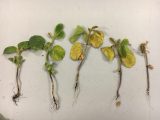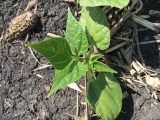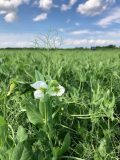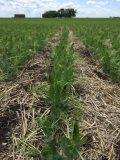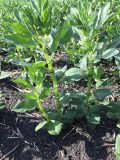JUNE 26, 2019
- Crop update
- Soybean Nodulation and Nitrogen Fixation
- Iron Deficiency Chlorosis (IDC)
- Hail Damage in Soybeans
- Summer Field Tours and Events:
- MPSG’s 35th Anniversary Golf Tournament in support of STARS – July 4, Starbuck
- Soybean Management and Research Transfer (SMART) Day – July 23, Carman
- Crops-a-palooza – July 24, Carberry
Listen to the Bean Report here:
Crop Update
Soybeans and dry beans – Bean staging ranges from VC to V3, with most at V1. However, flowering is near with the passing of the summer solstice. Root rot (Fusarium, Rhizoctonia and Phytophthora) symptoms continue to appear in some fields, while cutworms and grasshoppers continue to cause damage. Continue to assess pest pressure on a field by field basis. Iron deficiency chlorosis (IDC) symptoms are widespread in soybeans again this season, suggesting soluble salt levels may have increased since 2018.
Field peas and faba beans – Pea staging ranges from V9 (9th node) to R2 (beginning bloom) across the province, sitting mainly at the R1 (flower bud) stage. Faba beans are currently at R1 to R2. Flowering signals the timing for fungicide application. Early fungicide timing for peas is at R2 when flowers are open at one or more nodes. In faba beans, fungicide timing is at R2.5-R3 (20-50% flower), when flowers are open halfway up the main stem.
Check out the soybean, field pea, dry bean and faba bean growth staging guides for support with crop staging.
Assessing Soybean Nodulation and Nitrogen Fixation
- Assess nodulation at the R1 stage by gently digging up the root system and removing the soil. Soak roots in water to avoid breaking off nodules.
- Count the number of nodules per root system. Soybeans require at least 10 nodules per plant for maximized N-fixation and yield potential.
- Cut nodules open to assess activity. Nodules are active if they are pinkish-red inside.
- Scout for N-deficiency over the coming weeks. If nodulation failure has occurred, the crop will appear yellowish green in colour (not to be confused with IDC where leaf veins remain green).
- If rescue N treatment is necessary, apply 50 lbs N/ac of broadcast granular N or liquid N directed below the canopy at R2 (full flower) to R3 (early pod).
Read the latest research-based information on soybean inoculation strategies, nodule assessment in soybeans and nodule assessment in peas.
Iron deficiency chlorosis (IDC)
- Crops affected: Soybeans are most commonly affected in Manitoba. Dry beans, faba beans, and field peas can also be sensitive to IDC.
- Cause: Temporary iron deficiency in a plant. Reduced availability or uptake of iron by the plant after iron supplied by the seed is depleted.
- Symptoms: Interveinal chlorosis or yellowing of new soybean leaves, appearing as early as V1.
- Factors that increase risk: High levels of calcium carbonates, soluble salts, moisture and nitrates in the soil.
- In-season control: Options are limited. Waiting until the plants recover on their own is the most common practice. Yield loss is minimal if soybeans recover from IDC by V5-V6.
Soybean Recovery from Hail Damage
Were your soybeans damaged by hail but not written off? There is hope of more recovery than you might think. Research has been underway in the soybean and pulse agronomy research lab at the U of M. The goal: to generate Manitoba-based information on soybean defoliation and yield loss from hail.
Sharpen your Pulse & Soybean Agronomy Skills at SMART Day
July 23, 9:00 – 3:00 at the University of Manitoba Ian N Morrision Research Farm, Carman. Registration opens at 8:30 | Lunch will be provided.
Register today to reserve your spot!
This dynamic field tour will be featuring the following research highlights:
- Crop rotations for pulses and soybeans
- Cover crops to build soil health: new research in MB
- Emerging diseases in soybeans and pulses
- Novel and diverse weed management tools being tested in MB
- On-Farm Network vs. small plot research – answering inoculation questions and much, much more
Pre-registration is required. This event is free for farmers in good standing with MPSG. Agronomist/non-member fee is $50.



